QUESTIONS
SECTION A (40 marks)
Answer all questions in this section in the spaces providal
-
- Name two sectors in the metalwork industry. (1 marks)
-
- Give four levels of training technical personnel. (2 marks)
- Differentiate between industries in private and public sectors (2 marks)
-
- State two safety precautions to observe when using each of the following tools (2 marks)
- Hammer
- Cold chisel
- Sketch four types of cross sections in the mulcture of metal bars. (2 marks)
- State two safety precautions to observe when using each of the following tools (2 marks)
-
- Name four tools that can be used for both measuring and checking. (2 marks)
- State two care and maintenance practices related to a surface plate. (2 marks)
-
-
- Deline the term "marking out". (1 mark)
- Name two marking agents. (1 mark)
- State two uses of a trammel (1 mark)
-
- With the aid of sketches, differentiate between a countersunk hole and counterbored hole. (2 marks)
-
- State the use of each of the following tools (2 marks)
- Hatchet stake
- Creasing iron
- Name four methods of coating sheet metal. (2 marks)
- State the use of each of the following tools (2 marks)
-
-
- State four specifications necessary when ordering general purpose rivets (2 marks)
- State the type of rivet recommended for use in sheet metal, (1 mark)(1) (4)
-
- Define the term "burnt iron' with respect to soldering. (1 mark)
- Explain how to correct the problem in 7(b) (i) (2 marks)
-
-
- State two safety precautions to be observed when are welding a work piece. (2 marks)
- Define the following terms as applied in lathe work: (3 marks)
- Parallel turning (3 marks)
- Facing
- Knurling
-
- Explain the term "point of decalescence" as applied in heat treatment of metals. (1 mark)
- Name two factors to be considered when tempering steel. (2 marks)
-
- Define the term forging as used in medwork (1 mark)
- State the function of each of the following parts of an anvil (2 marks)
- Hard hole
- Punch hole
- State four methods of flaishing metal articles to prevent them from resting. (2 marks)
SECTION B (60 marks)
Answer question 11 on the A3 paper provided and any other three questions from this section in the spaces provided. Candidates are advised to spend not more than 25 minutes on question 11.
- Figure 1 shows a shaped block drawn in isometric projection.

Draw the following views Full Size in first angle projection: (15 marks)- Sectional front elevation along the cutting plane A-A
- End elevation in the direction of arrow E-E
- Plan
-
- Give four reasons for applying finishes on metallic articles. (4 marks)
-
- State four properties of cast iron. (2 marks)
- State two factors that make the electric furnace to produce high quality steel. (2 marks)
- Name four thread forms and give one application of each. (4 marks)
- Use a sketch to show a riveted double cover plate butt joint. (3 marks)
-
- Outline the procedure of each of the following processes
- Timing a soldering bit (4 marks)
- Sweat soldering a joint (5 marks)
- State the precautionary measures that should be taken in order to achieve a good soldered joint.
- Outline the procedure of each of the following processes
- Figure 2 shows a mild steel collar bush to be made on a lathe machine.
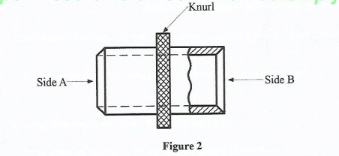
- Outline the procedure of making the bush. (9 marks)
- Outline the procedure of case-hardening the bush. (6 marks)
- Figure 3 shows a container made from galvanized sheet metal.
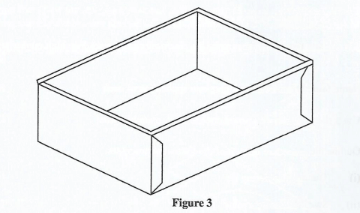
- Draw the surface development of the container. (8 marks)
- Live two reasons for making the wired edge on the container. (2 marks)
- Outline the procedure of making the wired edge. (5 marks)
MARKING SCHEME
-
- Sectors in metalwork industry
- Manufacturing industry.
- Service industry.
2 x 1⁄2-1 marks
-
- Levels of training technical personnel:
- Artisan
- Craft/ certificat
- Technician/diploma
- Degree
5 marks
- The industries in private sector are the companies owned by individuals while the public ones either partially or wholly owned by government or shareholders
- Levels of training technical personnel:
- Sectors in metalwork industry
-
- Safety precautions when using:
- Hammer Do not use a hammer with a loose head or a chipped one.
- Cold chisel Do not use a chisel which is not sharp at the tip or with a mushroomed head.
2x1-2 marks
-
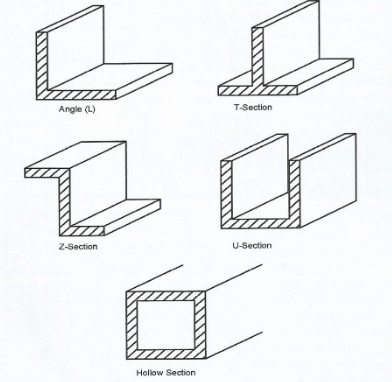
- Safety precautions when using:
-
- Tools used for both measuring and checking
- Steel rule.
- Engineer's square.
- Vernier caliper
- Protractor
- Vernier height gauge
4 x 1⁄2=2 marks
- Care and maintenance practices related to the surface plate:
- Handle with care
- Always keep it clean and oiled
- Storage should be in a safe place
3 marks
- Tools used for both measuring and checking
-
-
- Marking out is the process of outlining the profile of n item to be fabricated on the material to be used (mostly in the workshop).
- Marking out agents are:
- Copper sulphate solution
- Blue solution
- Chalk
Any 2x 1⁄2=1 mark
- Uses of trummel are:
- Drawing ares and grids of large radii
- Biscoting long ares
- Transferring large measurements
3 marks
-
-

-
- Use of:
- Hatchet stake
Used for turning edges beyond. - Creasing iron
Used for making angular bends, wiring. grooving.
- Hatchet stake
- Methods of coating sheet metal
- Electroplating
- Galvanizing
- Hot dipping
- Metal spraying
- Lacquering
Any 2x1 (2 marks)
- Use of:
-
-
- Specifications fo rivets
- Shape of head
- Diameter of shank
- Length of shank
- Material used
Any 4 x 1⁄2=2 marks
- Type of rivet recommended for use in sheet metal is the pop rivet.
1x11 mark
- Specifications fo rivets
-
- "Burnt iron" is the soldering hit that is overheated and has become heavily scaled and pitted.
- It can be corrected by cleaning with a file and tinning i
-
-
- Safety precautions to be observed when are welding
- Use protective clothing including overalls and hand gloves
- Use a welding shield to protect the eyes
- Use clear googles when removing the slag
- Make use of tongs and pliers for holding the metals.
Any 2x1=2 marks
-
- Parallel turning is the lengthwise traverse of the tool, which produces a round face."
- Facing is the cruss-traverse of the tool, which produces a flat face
- Knurling forming patterns on surface of a workpiece
3x1=3 marks
- Safety precautions to be observed when are welding
-
- Point of decalescence is when the temperature of steel being heated starts to remain stationery in the process of heating
- Factors to consider when tempering steel:
- Type of tool or article
- Function of tool or article
- Degree of hardness to be attained
-
- Forging is the process of shaping and forming metals by hammering when red hot.
- Functions of parts of an anvil
- Hardie hole is the square hole which takes the shank of bottom tools eg. fuller
- Punch hole is used as a clearance when punching holes in hot metal.
2 marks
- Methods of finishing metal article
- Use of shellac
- Enameling
- Coating with zinc powder
- Bronzing
- Painting
Any 4x-2 marks
-
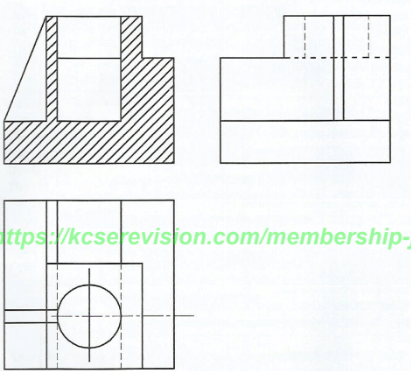
-
- Reasons for applying finish on metal articles
- To improve the physical appearance of the product (aesthetics)
- To prevent them from rusting
- To improve the surface of an article
- To increase the lifespan of the product
- To prevent tamishing.
-
- Properties of cast iron:
Cast iron:- is brittle
- is grey in colour
- is self' lubricating
- can be cast into intricate shapes
- is heavy
- has high machineability
- has high compression strength
Any 4 x 1=4 marks
- Electric furnace can produce high quality steel because:
- Heat can be controlled
- Regulation of oxygen in the system be a fine
- Properties of cast iron:
- Thread forms and their application:
- Buttress-for quick release mechanisms as in carpenter's vices.
- Acme for transmission of power and motion
- Square thread for transmission of power
- Vee thread for general use.
- A riveted double cover plate butt joint
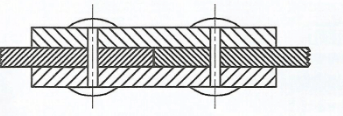
6 parts shown correctly 3 marks
- Reasons for applying finish on metal articles
-
-
- Procedure for tinning a soldering bit:
- Clean the soldering iron-file if necessar
- Heat to the correct temperature
- Clean with the flu
- Rub the solder on the iron to tin it.
4x14 marks
- Procedure of sweat soldering a joint:
- Clean the faces to be joined.
- Fit the parts together, such that the tinned faces lie on each other.
- Apply heat so that the solder in-between the parts melts, and hold the parts together until they bond
- Remove any excess solder
5x15 marks
- Procedure for tinning a soldering bit:
- Precautionary measures in order to achieve a good soldered joint
- Clean the joint area
- The joint must be close fittin
- Use correct flux
- Use the correct amount of heat for the solder
- The bit must be in good working condition and properly tinned
- Ensure the joint is cleaned after soldering
6x1=6 marks
-
-
- The procedure of making the bush
- Face both sides A and B
- Parallel tum the diameter of the portion to be knurled
- Parallel turn the smaller diameter on both sides
- Taper turn side A
- Centre drillside A
- Hold side B in the chuck and support side A with the dead centre
- Knurl the ring
- Fix the drill on the tail stock chuck and drill the hole
- Cut the taper on side B with a drill or tool bit
- Case hardening the bush:
- Remove all burrs and polish the bush
- Heat to a bright red colour
- Dip in kasenit compound (carbon)
- Allow it to cool slowly
- Reheat to a bright red colour
- Quench in oil/ brine/ water to harden the skin.
6 marks
- The procedure of making the bush
-
-

- Reasons for making wired edges:
- For strength
- For safety
- For aesthetics
Any 2x1=2 marks
- Procedure for making a wired edge:
- Mark out the allowance for the edge
- Bend along the folding line to a right angle using folding bars
- Tap over the edge further down over a metal bar with a rounded edge
- Place the wire in the grove and using a mallet, tap the edge further down
- Close down the edge using a hand groove
- Tuck in the end using a hatchet stake and tucking hammer.
Any 5x1=5 marks
-
Download Metal Work Paper 1 Questions and Answers - KCSE 2022 Past Papers.
Tap Here to Download for 50/-
Get on WhatsApp for 50/-
Why download?
- ✔ To read offline at any time.
- ✔ To Print at your convenience
- ✔ Share Easily with Friends / Students
